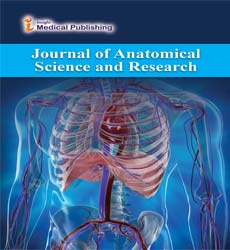Note on Skeletal Muscle
Brilan A. Karanmianaa*
1Department of Surgery, Rothman Institute, Thomas Jefferson University, Philadelphia, Pennsylvania, USA
- *Corresponding Author:
- Brilan A. Karanmianaa
Department of Surgery,
Rothman Institute,
Thomas Jefferson University,
Philadelphia,
Pennsylvania,
USA,
Tel: +251913567098;
E-mail: brian.karanmianaa@rothmanortho.com
Received Date: August 27, 2021; Accepted Date: September 10, 2021; Published Date: September 17, 2021
Citation: Karanmianaa BA (2021) Short Note on Skeletal Muscle. J Anat Sci Res Vol. 4 No.2:e001.
Editorial Note
Skeletal muscle is one of the most active and plastic tissues of the human body. In humans, skeletal muscle comprises roughly 40% of total body weight and carries 50% of all body proteins. In general, muscle mass anticipates on the balance between protein synthesis and degradation and both procedures are sensitive to factors such as nutritional status, hormonal balance, physical activity/ movement, and wound or disease, among others. Mammalian skeletal muscle fiber may have thousands of myonuclei, the significance of this number or the potential to regulate it in adult muscle has not been clearly exhibited. Using immunohistochemistry and confocal microscopy easy to studied the plasticity of myonuclear number a nd fiber size in remoted fast and slow fiber divisions.
From adult cat hindlimb muscles in response to chronic alterations in neuromuscular task and loading. The world population is ageing rapidly. As society ages, the frequency of physical limitations is dramatically increasing, which decreases the quality of life and escalates healthcare expenditures. In western society, ~30% of the people over 55 years is confronted with medium or critical physical limitations. These physical limitations escalate the risk of falls, institutionalization, comorbidity, and premature death. An significant root of physical restrictions is the age-related loss of skeletal muscle mass, also mentioned to as sarcopenia. Emerging proof, however, clearly appears that the decrease in skeletal muscle mass is not the sole contributor to the decrease in physical performance. For example, the loss of muscle strength is also a strong contributor to reduced physical performance in the elderly. Additionally, there is ample data to urge that motor coordination, excitation– contraction coupling, skeletal integrity, and other factors relavant to the nervous, muscular, and skeletal systems are critically significant for physical performance in the elderly.
Throughout embryogenesis, skeletal muscle shapes in the vertebrate limb from progenitor cells emerging in the somites. These cells strip from the hypaxial edge of the dorsal part of the somite, the dermomyotome, and migrate into the limb bud, where they proliferate, express myogenic determination factors and eventually differentiate into skeletal muscle. A number of regulatory factors involved in these unalike steps have been identified. These include Pax3 with its target c-met, Lbx1 and Mox2 as well as the myogenic resolution factors Myf5 and MyoD and factors needed for differentiation such as Myogenin, Mrf4 and Mef2 isoforms. Mutants for genes such as Lbx1 and Mox2, expressed in the same way in limb muscle progenitors, overt unexpected distincts between fore and hind limb muscles, also specified by the differential expression of Tbx genes. As growth proceeds, a secondary wave of myogenesis takes place, and, postnatally, satellite cells become located under the basal lamina of adult muscle fibres. Satellite cells are thought to be the progenitor cells for adult muscle regeneration, during which similar genes to those which regulate myogenesis in the embryo also play a role. In particular, Pax3 as well as its orthologue Pax7 are important. The origin of secondary/fetal myoblasts and of adult satellite cells is unclear, as is the relation of the latter to so-called SP or stem cell pupil, or indeed to potential mesangioblast progenitors, active in blood vessels. The regeneration of skeletal muscle is contrasted structurally and functionally with its embryonic growth. The free muscle graft is used as a model to elucidate the integration of regenerating muscle with the rest of the body.
Open Access Journals
- Aquaculture & Veterinary Science
- Chemistry & Chemical Sciences
- Clinical Sciences
- Engineering
- General Science
- Genetics & Molecular Biology
- Health Care & Nursing
- Immunology & Microbiology
- Materials Science
- Mathematics & Physics
- Medical Sciences
- Neurology & Psychiatry
- Oncology & Cancer Science
- Pharmaceutical Sciences
